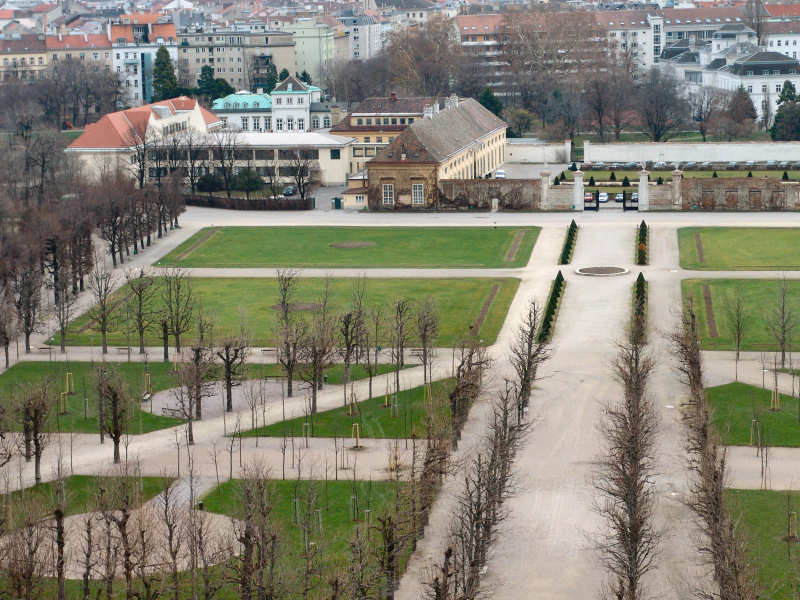Augarten

Obere Augartenstraße 1, 1020 Vienna
(690.011)
General and Historic Information
In 1614, Emperor Matthias had a hunting castle built in the Wolfsau area, which was an untouched meadow and floodplain partly used as imperial hunting grounds back then. Emperor Ferdinand III (1608-1657) bought another meadow area at "Am Tabor" around 1650. A Dutch-style garden was built and the hunting castle expanded. Emperor Leopold I (1640-1705) purchased the adjacent Trautson gardens around 1660 and had the Trautson garden palace remodelled into a castle around 1677, which he then called "Imperial Favorita". The imperial summer residence later became popularly known as "Old Favorita", which is also what the entry in the land register reads (Alte Favorita). The facilities on the premises were completely destroyed in the course of the Second Ottoman Siege. In 1705, Emperor Joseph I (1678-1711) had the garden and the palace rebuilt. The newly built part of the palace houses the Vienna’s Boys Choir. The rebuilt garden house (a wing of the destroyed palace) is now the seat of the porcelain manufacturer Augarten-Porzellanmanufaktur, Europe’s second oldest porcelain manufacturer.
Some years later in 1712, Charles VI (1685-1740) commissioned landscape architect Jean Trehet, who also designed the gardens of Schönbrunn Palace and the Belvedere, to create gardens in the French style. Augarten park still reflects this style to date.
After Empress Eleonore’s death (mother of Emperor Joseph I) Augarten park fell into oblivion, being less and less frequented by the imperial family and its court.
It was Joseph II (1741-1790) who revived the garden: The Emperor deeply influenced the further development of the abandoned park.
He had the damage from the Ottoman Siege repaired, and new alleys and pathways added to the garden. Until Emperor Joseph II’s reign, who finally opened Vienna’s oldest Baroque garden to the public in 1775, the Augarten park was exclusively for the imperial court and the nobility.
Augarten became famous primarily for its concerts. The morning concerts held at 7 or 8 a.m. depending on the season were of particular note. The park increased in value under Joseph II’s reign: The Emperor chose it as his personal area of recreation and leisure, he partly reigned from there and commissioned adaptations and restorations until the very end of his reign.
The French did not spare the Augarten in their invasion in 1805. The palace was used as a military hospital by the French. While Augarten park was a highly popular venue during the Viennese Congress in 1814/1815, it fell into oblivion just right afterwards. The entire area was flooded in March 1830. From 1860 to 1870, the flow of the Danube was regulated and thus the Augarten was separated from the Danube. The meadow area became a cultural landscape. Around the turn of the century, Augarten lost its function as a cultural centre. The castle and the palace were, again, converted into hospitals during the First World War. In the post-war period, they housed aristocrats from Russia and an array of organisations – such as the main office of the children’s aid organisation, the youth welfare office and a public kindergarten. Two anti-aircraft towers were erected during the Second World War to defend against air raids. Augarten got badly damaged as a result of the construction and intense fighting towards the end of the Second World War.
Today, the park, which comes with a total area of 52.2 hectares, is a popular place. It is oldest public park reflecting the Baroque style and it accommodates numerous cultural institutions.
Occupants:
Bundesgärten Wien & Innsbruck
Porcelain factory Augarten Wien
Vienna Boys Choir
MuTh – Concert hall of the Vienna Boys Choir
Universität Wien
Atelier Augarten, Ambrosimuseum
Filmarchiv Austria
Kino unter Sternen (outdoor cinema)
Die Schankwirtschaft (restaurant)
Pfarre Muttergottes (parish)
Haus Augarten, retirement home
Lauder Chabad Campus
Auwiese, school sports grounds
playgrounds
Public outdoor swimming pool for families/City of Vienna
Zentrale für Sportgeräteverleih und Sportplatz-Wartung (ZSSW) – user of the sports grounds
Building Management Dep. 405 – Government Building
HVAC Dep. 405 – Government Building
Administration Dep. 201 – Administration